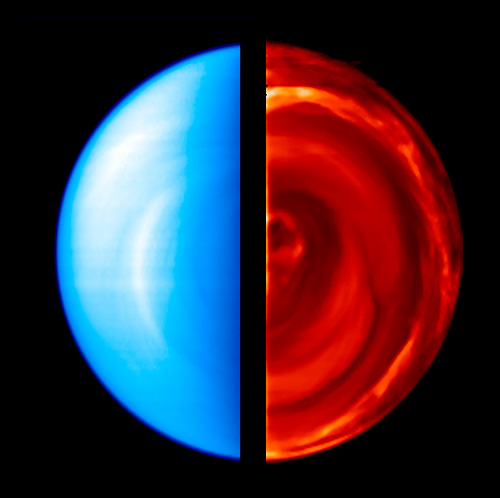IAstro draws more complete profile of Venus' winds

A team of researchers from the Institute of Astrophysics and Space Sciences (IAstro), the Faculty of Sciences of the University of Lisbon (Ciências ULisboa) and the University of Seville published a study this month in the scientific journal Atmosphere in which they present the most detailed and complete set of measurements ever made of wind speeds on Venus parallel to the equator and at cloud base altitude. Some of the measurements were unpublished and it is hoped that they will help to understand the unique characteristics of the planet closest to Earth, to which it is very similar in size.
The study, led by Pedro Machado, from IAstro e Ciências ULisboa, sought to study the movement of clouds in the atmosphere on the night side of Venus - the side that doesn't face the Sun, equivalent to the night period on Earth, which on Venus, because of the planet's long rotation time (243 Earth days), lasts much longer. The combination of observation from Earth, with the Telescopio Nazionale Galileo (TNG) in La Palma, in the Canary Islands, and data collected by the Venus Express probe of the European Space Agency (ESA), allowed the team to follow the movement of the clouds, using a method developed by Javier Peralta, from the University of Seville, co-author of the study, and indirectly calculate the speed of the wind that propels them at various different altitudes.
One of the unprecedented results was the simultaneous measurement of wind speeds at two altitudes 20 kilometers apart. The team found a difference in wind speed about 150 kilometers per hour faster at the top of the clouds. Venus' atmosphere is known to be peculiar, made up of thick clouds that create a huge greenhouse effect, causing the temperature near the ground to reach 460ºC. The planet's surface continuously emits infrared radiation - the so-called thermal emission - which heats up the lower layers of the atmosphere. In the words of Pedro Machado, the team has succeeded for the first time in "studying the vertical component of the wind, in other words, how energy is transported from the lower layers, which are warmer, to the top of the clouds, which will lead to the acceleration of the winds", helping to explain the relationship between the extremely hot surface and the cyclonic speeds of the clouds in the upper layers of Venus' atmosphere.
With the success of this approach, the team will now expand the research into the vertical component of the winds with new observations using the probe currently orbiting Venus, coordinated with observations made from Earth which, as this study has shown, make it possible to complement the study of the planet with data that the probes cannot obtain. In addition, the experience of IAstro and Portuguese researchers in understanding the dynamics of Venus' atmosphere will help choose the wavelengths of light at which the EnVision mission, the next from the European Space Agency ESA dedicated to Venus, will observe, as well as the layers of the atmosphere that are most relevant from a scientific point of view, thus contributing to the design and planning of the mission and its instruments. Portugal is involved in the development of this new mission, with the Portuguese consortium led by Pedro Machado, and it is hoped that this participation will enable Portuguese industry to be mobilized for yet another international ESA project, with the prospect of support from the Portuguese Space Agency, Portugal Space.
A more detailed article on the method and the results of this study can be found on the IAstro website.